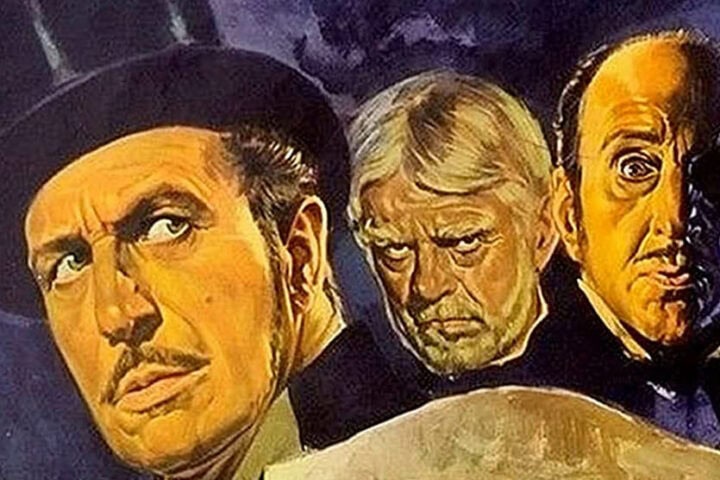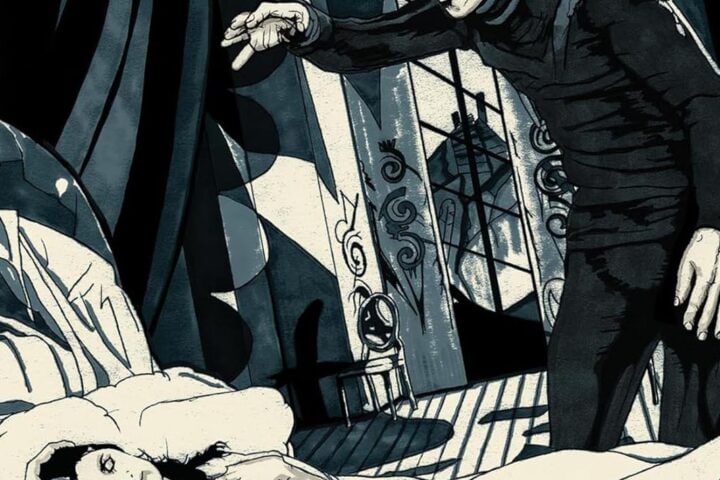The horror films produced by Val Lewton for RKO Studios throughout the 1940s all share DNA, though the third and fourth films in the cycle, Jacques Tourneur’s I Walked with a Zombie and Mark Robson’s The Seventh Victim, seem to be especially connected. Both were released in 1943 and concern protagonists who enter hidden worlds beyond their understanding, worlds that allude to rot existing in conventional society should one care to acknowledge it. The protagonists’ growing awareness parallels our own, though in each case the viewer is left with little hope for reform or closure. They have glimpsed nightmare realms and are humbled by what they discover about their societies as well as themselves.
Notions of reform are particularly relevant to I Walked with a Zombie, which offers an unusually nuanced portrait of the legacy of colonialism. Betsy Connell (Frances Dee), a nurse from snowy Ottawa, is hired to care for the ailing Jessica (Christine Gordon), the wife of Paul Holland (Tom Conway), who runs a sugar plantation on the fictional Caribbean island of Saint Sebastian. As Betsy becomes enmeshed in the networks of white and Afro-Caribbean characters who live and work on the island, she drifts closer to the heart of the evil that drives and haunts this ecosystem, bringing men like Holland great influence.
Paul himself observes in an early scene that Saint Sebastian’s beauty is informed by death: from fish jumping out of the ocean to evade predators to decaying microorganisms who give the ocean its glow to dying stars lighting the sky. As Betsy hears more stories of the island, these allusions come to explicitly reference the slave trade that built the community. Curt Siodmak and Ardel Wray’s screenplay, based on an article of the same name by Inez Wallace and drawing influence from Charlotte Brontë’s Jane Eyre, is straightforward on these matters. When Betsy’s Black driver mentions slaves being brought to Saint Sebastian, she observes with astonishing insensitivity that they were taken to a beautiful place. The driver’s ironic response contains a lifetime’s worth of experience in humoring clueless beneficiaries of racism.
One can imagine the pat racial parable that might emerge from this scenario, which is common in horror films today that follow people who enter unwittingly into secret networks and learn of their diseased practices and emerge enlightened to the implications of timeless and socially sanctioned barbarism, usually of the racist and sexist varieties. Jordan Peele’s Get Out is the embodiment of the current version of this narrative, pivoting on an us-versus-them template that has a way of letting viewers off the hook of its implications. By contrast, I Walked with a Zombie is subtler and thornier, showing how tangled traditions, nursed by oppressed and oppressor alike, create unexpected lines of influence and power.
This description may sound baffling to people who’ve heard I Walked with a Zombie discussed primarily as an unusually classy blend of horror and noir with early references to vodou and zombies. Those sentiments are also true, but much of the film’s extravagantly dense plotting is devoted to defining spheres of power that exist between the descendants of white colonialists and the ancestors of African slaves who live in a world that appears to be hidden and self-contained, yet informs mainstream white society in countless fashions.
This world of vodou, derived in part as a response to slavery, can be accessed with disconcerting ease via a walk through a liminal realm of billowing fields, creating confusions of politics, class, and identity. For instance, a pivotal white character utilizes vodou for revenge, while also helping the African descendants by passing off modern medicine as ancient magic.
The wealth of plot information and the diaphanously poetic imagery is collectively head-spinning, yielding scenes that feel lucid and intangible at once. The Lewton horror films are above all masterworks of flow, with sculptural shadows and camera movements that coalesce to suggest a state of sensual dread. As in Tourneur’s Cat People, sex unearths atrocity in I Walked with a Zombie, as Betsy’s attraction to Paul reveals generations of madness and institutional sadism that are often represented by tactile, brutally efficient symbols.
A close-up of the figurehead of the Holland family slave ship, an African man riven with arrows and framed in the shadows of the night, is worth a hundred monologues on the legacy of colonialism. Other objects suggest death, estrangement, sickness, and purgatory: a skull in a field, a staircase gleaning white among the darkness, and, most unforgettably, the body of a Black man named Carrefour (Darby Jones), a zombie with cloudy eyes who’s positioned by Tourneur most vividly as a figure of poignancy rather than fear.
The Seventh Victim is structured similarly to the Tourneur film, following another woman who enters into another mystery and via an awakening of desire discovers another wellspring of social sickness. While attending an elite boarding school, Mary (Kim Hunter) is informed that her sister, Jacqueline (Jean Brooks), is missing. Mary leaves the school and investigates Jacqueline’s life in Greenwich Village, which leads her to a satanic cult.
Like I Walked with a Zombie, The Seventh Victim is animated by controversial issues that imbue its gothic hugger-mugger with intimacy and intensity—in this case, depression and suicide. The film can be frustrating to watch despite its profound beauty and fluidity because the plot keeps refusing to snap into place and take us somewhere. We keep meeting characters, including Tom Conway’s psychiatrist from Cat People, and they keep revealing things that seem borderline beside the point. The Seventh Victim comes to suggest a frustration dream. At times, you wish the film would slow down and let you savor the extraordinary mood and style.
An early scene offers a tip-off to the film’s obsessions. An administrator at Mary’s school tells her not to return and make the mistake that she did long ago, retreating from life into this institution. That sense of futility casts a pall over The Seventh Victim, especially once Jacqueline surfaces. Haunted and gorgeous, with dark hair framed by bangs that seem to form a rectangle, somehow suggesting that her face is a kind of mask, Jacqueline embodies the fear of the liminal zone separating life from death that animates all of Lewton’s horror films. Jacqueline says matter-of-factly that she wants to die and the filmmakers take her on her terms. These suggestions are taboo in cinema now, let alone in the 1940s.
Jacqueline’s suicidal impulses are rhymed with the entrapment felt by the administrator in the film’s first scenes, and with most of the other characters in one way or another. The Seventh Victim is riven with traps common in life: of the workplace, of the mind, of the neighborhoods that you can’t bear to leave, even though they stifle you. When Jacqueline walks a city street lit in perfect noir shadows, the street seems to change shape and the editing breaks it up into shards of despairing imagery that physicalize inescapable alienation. Jacqueline is dead before she’s dead, on the verge of being swallowed up by her own anguish. And that’s what all of the Lewton horror films are about: uncovering the part of yourself that can destroy you.
Image/Sound
These 4K restorations of these films are stunning, especially when one considers a note included in the liner booklet: “The negative of The Seventh Victim had large amounts of mold throughout. Digital restoration helped mitigate the damage, but there is still some mold residue present in the picture.” I couldn’t personally detect deterioration in The Seventh Victim, perhaps a bit of softness in the whites, though that itself is beautiful and probably intentional. Shadows, always a standout in Val Lewton’s films, are rich and varied and immersive here, and detail and clarity are top notch, especially in terms of rendering the faces of actors. The monaural soundtracks included with each film have a few hiccups, hisses, and cracks that are almost certainly inherent to the source materials, but they sound full and healthy.
Extras
A new interview with film historian Imogen Sara Smith and the 2005 documentary Shadows in the Dark: The Val Lewton Legacy collectively offer a comprehensive portrait of Lewton, the cycle of horror films that he produced for RKO Studios in the 1940s, and their remarkable blend of dream-like poetics and sociopolitical irony. Archive audio commentaries from prior Criterion editions of each film have been preserved here as well: For I Walked with a Zombie, authors Kim Newman and Stephen Jones make for an engagingly conversational and informed listen, as does Steven Haberman for The Seventh Victim. Excerpts from “The Origin of the Zombie, from Haiti to the U.S.,” from the PBS series Monstrum, is a shrewd inclusion that offers quick context regarding the Haitian culture that informs the plot of I Walked with a Zombie. Audio essays from Adam Roche’s podcast The Secret History of Hollywood, rich with stories of the various people involved with the various productions, trailers, and a booklet with essays by Chris Fujiwara and Lucy Sante round out an eclectic and informative package.
Overall
Two of the best of Val Lewton’s rich and haunting horror gothics have been outfitted by the Criterion Collection with ravishing transfers.
Since 2001, we've brought you uncompromising, candid takes on the world of film, music, television, video games, theater, and more. Independently owned and operated publications like Slant have been hit hard in recent years, but we’re committed to keeping our content free and accessible—meaning no paywalls or fees.
If you like what we do, please consider subscribing to our Patreon or making a donation.



